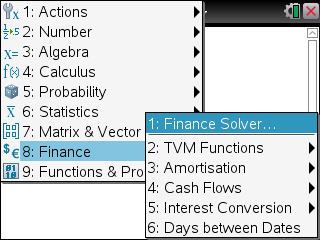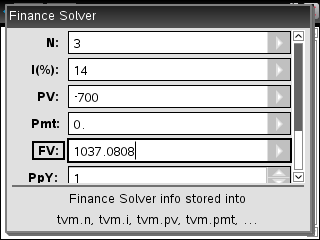
 |
InterestPractise calculating simple interest and compound interest on investments and loans. |
This is level 5; Interest calculated half-yearly, quarterly or monthly. Give all of your answers to two decimal places. You can earn a trophy if you get at least 7 correct and you do this activity online.
InstructionsTry your best to answer the questions above. Type your answers into the boxes provided leaving no spaces. As you work through the exercise regularly click the "check" button. If you have any wrong answers, do your best to do corrections but if there is anything you don't understand, please ask your teacher for help. When you have got all of the questions correct you may want to print out this page and paste it into your exercise book. If you keep your work in an ePortfolio you could take a screen shot of your answers and paste that into your Maths file. |
||
|
|
||
|
|

|
More Activities: |
|
Mathematicians are not the people who find Maths easy; they are the people who enjoy how mystifying, puzzling and hard it is. Are you a mathematician? Comment recorded on the 2 May 'Starter of the Day' page by Angela Lowry, : "I think these are great! So useful and handy, the children love them. Comment recorded on the 9 May 'Starter of the Day' page by Liz, Kuwait: "I would like to thank you for the excellent resources which I used every day. My students would often turn up early to tackle the starter of the day as there were stamps for the first 5 finishers. We also had a lot of fun with the fun maths. All in all your resources provoked discussion and the students had a lot of fun." |
Each month a newsletter is published containing details of the new additions to the Transum website and a new puzzle of the month. The newsletter is then duplicated as a podcast which is available on the major delivery networks. You can listen to the podcast while you are commuting, exercising or relaxing. Transum breaking news is available on Twitter @Transum and if that's not enough there is also a Transum Facebook page. |
|
AnswersThere are answers to this exercise but they are available in this space to teachers, tutors and parents who have logged in to their Transum subscription on this computer. A Transum subscription unlocks the answers to the online exercises, quizzes and puzzles. It also provides the teacher with access to quality external links on each of the Transum Topic pages and the facility to add to the collection themselves. Subscribers can manage class lists, lesson plans and assessment data in the Class Admin application and have access to reports of the Transum Trophies earned by class members. If you would like to enjoy ad-free access to the thousands of Transum resources, receive our monthly newsletter, unlock the printable worksheets and see our Maths Lesson Finishers then sign up for a subscription now: Subscribe |
||
Go MathsLearning and understanding Mathematics, at every level, requires learner engagement. Mathematics is not a spectator sport. Sometimes traditional teaching fails to actively involve students. One way to address the problem is through the use of interactive activities and this web site provides many of those. The Go Maths page is an alphabetical list of free activities designed for students in Secondary/High school. Maths MapAre you looking for something specific? An exercise to supplement the topic you are studying at school at the moment perhaps. Navigate using our Maths Map to find exercises, puzzles and Maths lesson starters grouped by topic. | ||
Teachers | ||
|
If you found this activity useful don't forget to record it in your scheme of work or learning management system. The short URL, ready to be copied and pasted, is as follows: |
Alternatively, if you use Google Classroom, all you have to do is click on the green icon below in order to add this activity to one of your classes. |
It may be worth remembering that if Transum.org should go offline for whatever reason, there is a mirror site at Transum.info that contains most of the resources that are available here on Transum.org. When planning to use technology in your lesson always have a plan B! |
|
Do you have any comments? It is always useful to receive feedback and helps make this free resource even more useful for those learning Mathematics anywhere in the world. Click here to enter your comments. |
||
© Transum Mathematics 1997-2025
Scan the QR code below to visit the online version of this activity.
https://www.Transum.org/go/?Num=506
Close

Percentages - Before starting the Interest exercise make sure you are confident finding percentages of quantities.
Compare: - A table to be filled in Comparing the results of investing with simple interest against the results of investing with compound interest.
Level 1 - Investments earning simple interest
Level 2 - Investments earning compound interest
Level 3 - Loans accruing compound interest
Level 4 - Appreciation and depreciation
Level 5 - Interest calculated half-yearly, quarterly or monthly
Level 6 - Additional payments made during the investment period
Level 7 - Artificial intelligence generated questions
Overdraft Charges - Do you understand how your bank charges you for taking out an overdraft?
Amortisation and Annuities - An exercises containing problems about gradually paying off loans and calculating pension plans.
Exam Style Questions - A collection of problems in the style of GCSE or IB/A-level exam paper questions (worked solutions are available for Transum subscribers).
More on this topic including lesson Starters, visual aids, investigations and self-marking exercises.
Answers to this exercise are available lower down this page when you are logged in to your Transum account. If you don’t yet have a Transum subscription one can be very quickly set up if you are a teacher, tutor or parent.
See the National Curriculum page for links to related online activities and resources.
\(P\) is the principal, the amount originally invested.
\(r\) is the rate of interest expressed as a percentage.
\(n\) is the number of years the amount was invested for.
\(k\) is the number of compounding periods per year.
If you are following a syllabus that allows the use of a graphic display calculator you could use the Finance Solver to help calculate answers for the compound interest questions.


Don't wait until you have finished the exercise before you click on the 'Check' button. Click it often as you work through the questions to see if you are answering them correctly. You can double-click the 'Check' button to make it float at the bottom of your screen.
Answers to this exercise are available lower down this page when you are logged in to your Transum account. If you don’t yet have a Transum subscription one can be very quickly set up if you are a teacher, tutor or parent.
Transum subscriber Ann never fails to come up with some really interesting observations. Recently she has been time travelling:
“When I first used the compound interest formula it was introduced as the ‘future value’ formula.
Have you ever travelled back in time and used a negative value for n in the formula?
Surprisingly there’s no mention of using the formula when n is negative. Why do you think that is?
I think it’s a wonderful thing to notice that the compound interest formula can be used without any rearranging to find future values or past values. I’d be interested to get your opinion.
Maybe it’s just easier for students to think of multiplying by (1+r)n to find the future value and to divide by (1+r)n when finding the past value?”
Close

Transum,
Tuesday, September 10, 2024
"As a rough, 'rule of thumb' for compound interest, divide 72 by the percentage interest rate and you’ll have a great estimate for the number of years required for your investment to double in value."